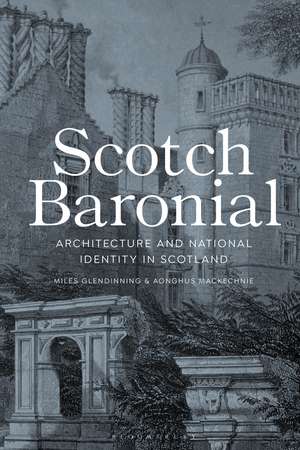Scotch Baronial: Architecture and National Identity in Scotland
Autor Miles Glendinning, Aonghus MacKechnieen Limba Engleză Hardback – 9 ian 2019
| Toate formatele și edițiile | Preț | Express |
|---|---|---|
| Paperback (1) | 185.20 lei 3-5 săpt. | +55.95 lei 4-10 zile |
| Bloomsbury Publishing – 27 ian 2021 | 185.20 lei 3-5 săpt. | +55.95 lei 4-10 zile |
| Hardback (1) | 500.85 lei 6-8 săpt. | |
| Bloomsbury Publishing – 9 ian 2019 | 500.85 lei 6-8 săpt. |
Preț: 500.85 lei
Preț vechi: 690.45 lei
-27% Nou
Puncte Express: 751
Preț estimativ în valută:
95.85€ • 99.70$ • 79.13£
95.85€ • 99.70$ • 79.13£
Carte tipărită la comandă
Livrare economică 15-29 aprilie
Preluare comenzi: 021 569.72.76
Specificații
ISBN-13: 9781474283472
ISBN-10: 1474283470
Pagini: 312
Ilustrații: 91 bw illus
Dimensiuni: 156 x 234 x 21 mm
Greutate: 0.66 kg
Editura: Bloomsbury Publishing
Colecția Bloomsbury Visual Arts
Locul publicării:London, United Kingdom
ISBN-10: 1474283470
Pagini: 312
Ilustrații: 91 bw illus
Dimensiuni: 156 x 234 x 21 mm
Greutate: 0.66 kg
Editura: Bloomsbury Publishing
Colecția Bloomsbury Visual Arts
Locul publicării:London, United Kingdom
Caracteristici
Fills a gap in scholarship: 'national' architectures are of growing interest in architectural history, and yet the Scotch Baronial has so far been largely overlooked.
Notă biografică
Miles Glendinning is Professor of Architectural Conservation at the Edinburgh School of Architecture and Landscape Architecture, University of Edinburgh, UK.Aonghus MacKechnie is an architectural historian and Head of Heritage Management at Historic Scotland. Together, they have co-authored numerous books including A History of Scottish Architecture (1996, co-authored with Ranald MacInnes), and Scottish Architecture (2004).
Cuprins
Introduction: Pre-1603 Scotland: Castellated Architecture and 'Martial Independence' Part I: Absent Monarchs and Civil Strife Chapter 1: 1603-1660: Empty royal palaces and castellated court architectureChapter 2: 1660-1689: From restitution to rejection of the old orderChapter 3: 1689-1750: The architecture of dynastic struggle Part II: From 'Romantic Scotland' to 'Imperial Scotland' Chapter 4: 1750-1790: Enlightenment and RomanticismChapter 5: 1790-1820: Scotland and England in the Age of Revolutionary WarChapter 6: 1820-40: Scott, Abbotsford and 'Scotch' Romanticism Chapter 7: 1840-70: Billings and Bryce: mid-century Baronial Chapter 8: 1870-1900: TraditionalismChapter 9: External reflections: 'national' Scottish architecture and the empire Part III: The Twentieth CenturyChapter 10: 1914 onwards: Scottish architectural identity in the age of ModernismConclusion: The architecture of Unionist Nationalism - and its international significanceBibliographyIndex
Recenzii
An ambitious and wide-ranging but closely argued and well referenced account of the complex interplay, over more than eight centuries, between castellated architecture in its original and revival forms and changing concepts of national identity in Scotland ... The authors are to be congratulated on maintaining an appropriate balance and pace across such a broad chronological span and such an intricately interwoven set of themes.
It is always a pleasure to pick up an elegantly written book, which wears its research lightly, yet doesn't skimp on scholarship.
A rich and thought-provoking overview of Scotland's pre-eminent national style.
It is always a pleasure to pick up an elegantly written book, which wears its research lightly, yet doesn't skimp on scholarship.
A rich and thought-provoking overview of Scotland's pre-eminent national style.
